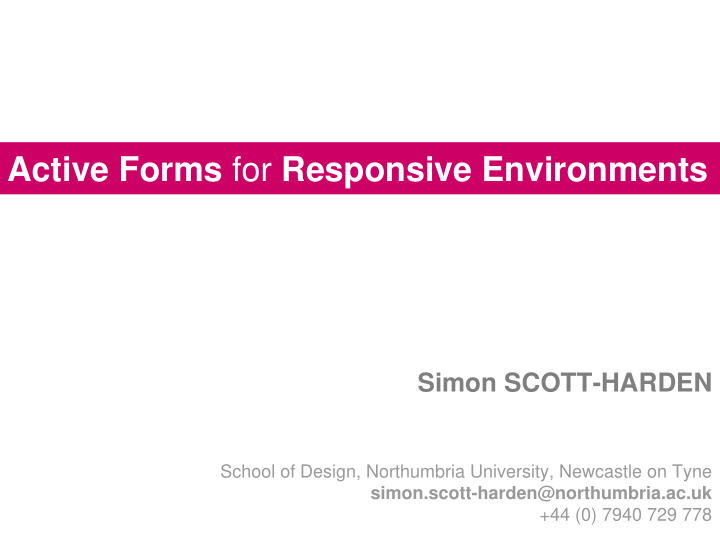



Active Forms for Responsive Environments Simon SCOTT-HARDEN School of Design, Northumbria University, Newcastle on Tyne simon.scott-harden@northumbria.ac.uk +44 (0) 7940 729 778
Research Overview This research is on Active Forms, which we define as interactive devices that act as gateways to Responsive Environments. Responsive Environments are physical spaces enhanced with an Ambient Intelligence System that deliver context awareness, ubiquitous computing, natural interaction and a predefined user experience (UX)*. The research proposed is multi-disciplinary in nature and involves product and interaction design, as well as user interface and adaptation. * Alves Lino J., Salem B., Rauterberg M., Responsive Environments: User Experience for Ambient Intelligence
Background Active Forms are an extension of Tangible User Interfaces (initially known as graspable interfaces). Active Forms are about symmetrically coupling digital and physical elements of an interface in an Integrating Combination. With an Active Form, interactive tasks are performed through physical manipulations. Active Forms are acted on (as an object), acted with (as an interface) and acted through (as a gateway).
TUI vs. Active Forms TUI are reactive devices that require a user input to change shape or appearance. Active Forms are interactive devices that change shape and appearance as a result of the following: • User actions. • A change to the internal state of the device. • To the embodied application. There is a connection that appears seamless to the user, between the Active Form as a physical object, an interactive device and the system beyond it: the responsive environment
Key Features of Active Forms Active Forms are interactive devices that are both reactive to user actions and proactive in displaying information. They are a gateway to applications or services (e.g. RE). Changes in Active Forms are a result of either, user actions or internal actuators; both in the physical form and in appearance. The user actions and the device reactions are merged and are spatially co-located. Active Forms act as the RE embodiment; as physical objects, and have aesthetic value per se.
Requirements of Active Forms h t d i w y d t i n l e i b a c a n B e t i n u i e r s n o e S c c o p i n t i t t i a x a t x e a E m d e h r r t g r t r o n s e o e e f o s f t f n n U A A C I I
Active Forms: Zutea Zutea: Ruben Meeldijk
Active Forms: EmDis Embody the Disembodied: Vic van Hensberg
RE: Atmosphere Flipbook Atmosphere Flipbook: Philips Research
Current Technologies: ShapeShift ShapeShift : Electro-Active Polymer Exploration, ETH Zurich
The Future: ET and Shaking Hands
Research Methods Empirical Research through Design Method* • Hypothesis of a causal relationship between design choices, usability and UX • Functional prototypes of Active Forms will be used to run experiments within a RE Development Development Development Iteration 1 Iteration 2 Iteration 3 * Keyson D.V., Bruns Alonso, M., Empirical Research Through Design
Key Research Questions How to design, measure and assess the user experience? What will the embedded interaction be and how to couple it with the affordance of the Active Forms? How to effectively merge the modalities afforded by the Active Form? What algorithms for user adaptation should be investigated to ensure a tailored interaction (one that is refined when the user is gaining expertise)?
Supervisor: Dr Benjamin SALEM Active Forms for Responsive Environments Simon SCOTT-HARDEN School of Design, Northumbria University, Newcastle on Tyne simon.scott-harden@northumbria.ac.uk +44 (0) 7940 729 778
Recommend
More recommend